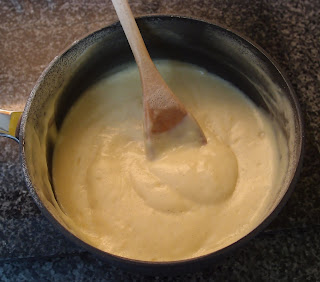
Good Housekeeping’s “New Cooking” was published in 1964 and the cover couldn’t scream “1960s” any louder if it tried! It’s hard to believe, but the couple on the cover could be well into their seventies now! The back cover shows their swanky and covetable kitchen/diner. At the time it was probably cutting edge but now looks rather kitsch and retro. I suppose all our kitchens will look that out of date in 50 years’ time!
As soon as I found this gem of book, priced at a meagre 50p, on a second hand bookstall in my local market I knew it was coming home with me. What instantly struck me was that, even though the book acknowledges that young couples are likely to both work, matters of running the household and cooking fall squarely on the wife’s shoulders.
One section is brilliantly titled “how much will he eat?” and provides guidance as to the quantities of food you should give your husband. No offence to the fragrant and delightful Mr CC, but I would not look forward to an evening where I had given him ½ lb of cabbage for dinner!
All the feminists out there will love the section titled, “Wife at work”. For your entertainment I shall quote directly: “the career-wife really has to put her back into the catering problem, or she will find herself eternally serving fish fingers and frozen peas.” Feeling a bit of a bristle yet? Let me continue: “Try to organise some of your cooking ahead. An hour’s baking on Saturday can provide flan cases for mid-week puddings, a meat or fruit pie for Monday or Tuesday, a fruity cake to eat with coffee instead of having to make a sweet.”
The chapter covering entertaining does at least manage to patronise both the husband and wife: “Slick cooperation between husband and wife makes all the difference to smooth running dinner parties...and it you have trained him to make the coffee and to wash up afterwards – well, good for you!”
This is actually a really good cook book packed with some lovely and unusual recipes. I found it hard to select just one for this post but eventually went for the pineapple and walnut cake simply because it uses two of my favourite ingredients.
The recipe was written in ounces so I include those in the listing below. The glace icing is my own addition.
I also made English Madeleines this week; I’ve made them before (recipe can be found here) but this time used my new Dr Oetker cake release spray. Dariole moulds can be a terror for turning out cakes but they just slid out! Great product.
Ingredients
200g / 7oz unsalted butter, at room temperature
140g / 5oz caster sugar
3 eggs
255g / 9oz self raising flour
225g / 8oz drained canned crushed pineapple – save the juice for the icing
55g / 2oz walnuts, chopped
2 tablespoons warm water
Optional glace icing:
200g/ 7oz icing sugar
3 tablespoons pineapple juice, from the can of pineapple
To decorate: walnut halves
Method
Preheat the oven to 180˚C/ fan oven 160˚C/350˚F/Gas mark 4.
Line a 20cm round springform tin with baking paper.
Beat together the butter and sugar until light and fluffy. This will take several minutes so don’t skimp and move on too quickly.
Add the eggs, one at a time, beating as you go. If the mixture looks like it might curdle add a little of the flour. (If you spent long enough whipping up the butter and sugar, the mix shouldn’t curdle).
Fold in the flour.
Stir in the pineapple, walnuts and warm water.
Spoon into the prepared cake tin and level the surface.
Bake for approximately 1 hour – 1 hour 15minutes or until a skewer inserted into the cake comes out cleanly.
Place the cake, still in its tin, on a wire rack and leave to cool.
Remove the cake from the tin when it is cool enough to safely handle, and then leave the cake on the wire rack until cool.
The cake will store for several days in an airtight container.
If you wish to make the glace icing simply combine the icing sugar and pineapple juice in a bowl and whisk until you have a thick white icing.
Pour onto the cake, it will run down the sides a little but not too much.
Place walnut halves on top for decoration
Bask in the glory of the wonderful thing you have created.
Eat.






































